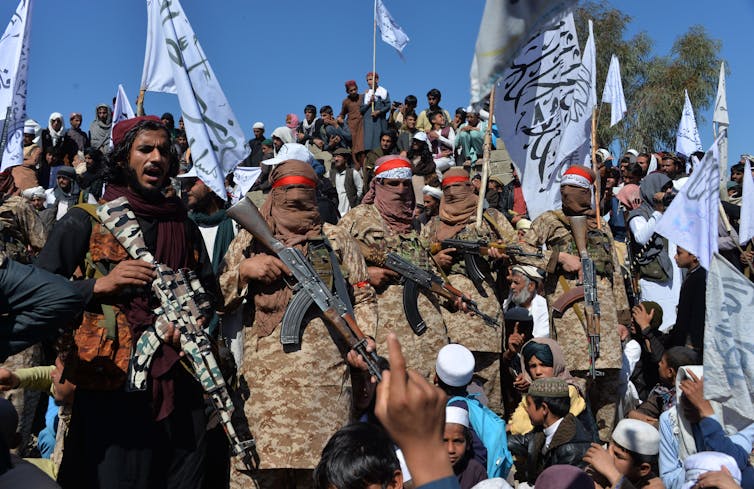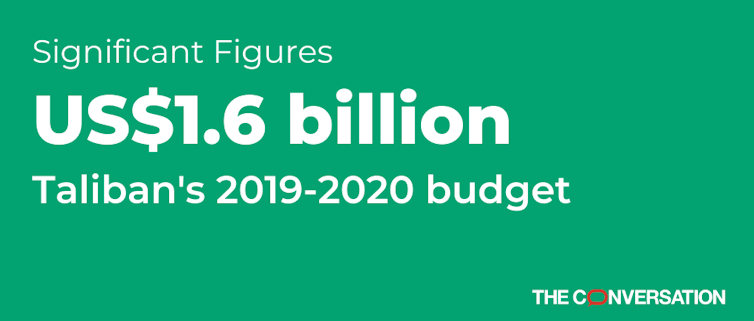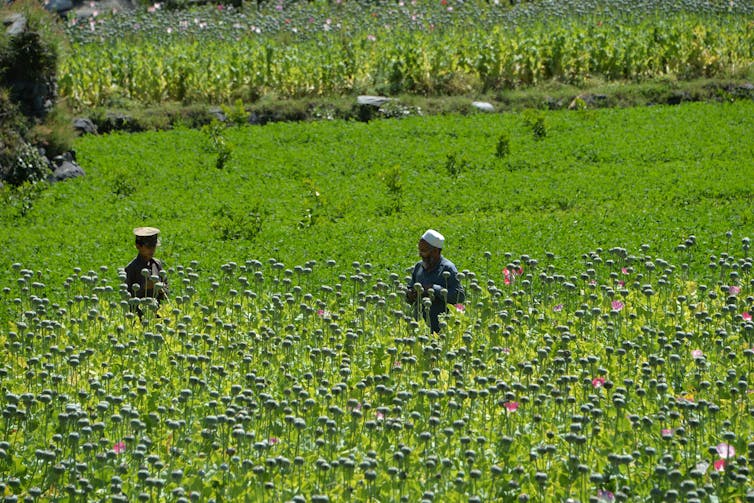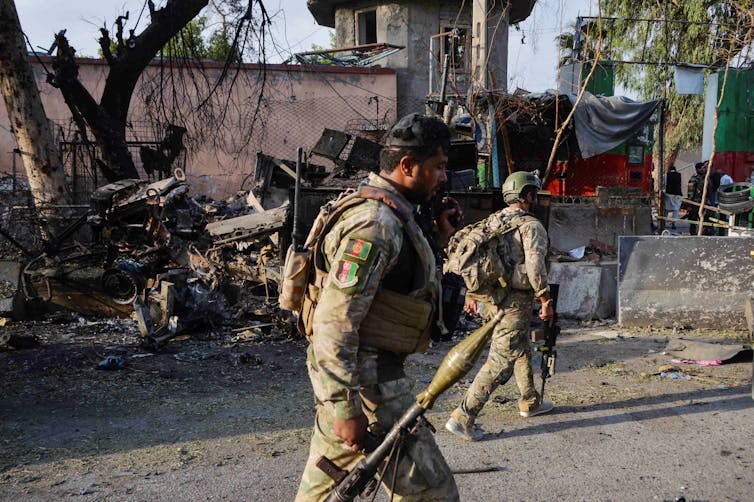There are many reasons to root for peace in war-scarred Afghanistan, writes Hanif Sufizada. Its financial health is one of them.![]()

(Noorullah Shirzada/AFP via Getty Images)
By Hanif Sufizada
University of Nebraska Omaha

 The Taliban militants of Afghanistan have grown richer and more powerful since their fundamentalist Islamic regime was toppled by U.S. forces in 2001.
The Taliban militants of Afghanistan have grown richer and more powerful since their fundamentalist Islamic regime was toppled by U.S. forces in 2001.
In the fiscal year that ended in March 2020, the Taliban reportedly brought in $1.6 billion, according to Mullah Yaqoob, son of the late Taliban spiritual leader Mullah Mohammad Omar, who revealed the Taliban’s income sources in a confidential report commissioned by NATO and later obtained by Radio Free Europe/Radio Liberty.
In comparison, the Afghan government brought in $5.55 billion during the same period. The government is now in peace talks with the Taliban, seeking to end their 19-year insurgency.
I study the Taliban’s finances as an economic policy analyst at the Center for Afghanistan Studies. Here’s where their money comes from.
1. Drugs – $416 million
Afghanistan accounted for approximately 84 percent of global opium production over the past five years, according to the United Nation’s World Drug Report 2020.
Much of those illicit drug profits go to the Taliban, which manage opium in areas under their control. The group imposes a 10 percent tax on every link in the drug production chain, according to a 2008 report from the Afghanistan Research and Evaluation Unit, an independent research organization in Kabul. That includes the Afghan farmers who cultivate poppy, the main ingredient in opium, the labs that convert it into a drug and the traders who move the final product out of country.

(Noorullah Shirzada/AFP via Getty Images)
2. Mining – $400 Million to $464 Million
Mining iron ore, marble, copper, gold, zinc and other metals and rare-earth minerals in mountainous Afghanistan is an increasingly lucrative business for the Taliban. Both small-scale mineral-extraction operations and big Afghan mining companies pay Taliban militants to allow them to keep their businesses running. Those who don’t pay have faced death threats.
According to the Taliban’s Stones and Mines Commission, or Da Dabaro Comisyoon, the group earns $400 million a year from mining. NATO estimates that figure higher, at $464 million – up from just $35 million in 2016.
3. Extortion & Taxes – $160 Million
Like a government, the Taliban tax people and industries in the growing swath of Afghanistan under their control. They even issue official receipts of tax payment.
“Taxed” industries include mining operations, media, telecommunications and development projects funded by international aid. Drivers are also charged for using highways in Taliban-controlled regions, and shopkeepers pay the Taliban for the right to do business.
The group also imposes a traditional Islamic form of taxation called “ushr” – which is a 10 percent tax on a farmer’s harvest – and “zakat,” a 2.5 percent wealth tax.
According to Mullah Yaqoob, tax revenues – which may also be considered extortion – bring in around $160 million annually.
Since some of those taxed are poppy growers, there could be some financial overlap between tax revenue and drug revenue.
4. Charitable Donations – $240 million
The Taliban receive covert financial contributions from private donors and international institutions across the globe.
Many Taliban donations are from charities and private trusts located in Persian Gulf countries, a region historically sympathetic to the group’s religious insurgency. Those donations add up to about $150 million to $200 million each year, according to the Afghanistan Center for Research and Policy Studies. These charities are on the U.S. Treasurey Department’s list of groups that finance terrorism.
Private citizens from Saudi Arabia, Pakistan, Iran and some Persian Gulf nations also help finance the Taliban, contributing another $60 million annually to the Taliban-affiliated Haqqani Network, according to American counterterrorism agencies.

(Norrullah Shirzada/AFP via Getty Images)
5. Exports – $240 Million
In part to launder illicit money, the Taliban import and export various everyday consumer goods, according to the United Nations Security Council. Known business affiliates include the multinational Noorzai Brothers Limited, which imports auto parts and sells reassembled vehicles and spare automobile parts.
The Taliban’s net income from exports is thought to be around $240 million a year. This figure includes the export of poppy and looted minerals, so there may be financial overlap with drug revenue and mining revenue.
6. Real Estate – $80 Million
The Taliban own real estate in Afghanistan, Pakistan and potentially other countries, according to Mullah Yaqoob and the Pakistani TV Channel SAMAA. Yaqoob told NATO annual real estate revenue is around $80 million.
7. Specific Countries
According to BBC reporting, a classified CIA report estimated in 2008 that the Taliban had received $106 million from foreign sources, in particular from the Gulf states.
Today, the governments of Russia, Iran, Pakistan and Saudi Arabia are all believed to bankroll the Taliban, according to numerous U.S. and international sources. Experts say these funds could amount to as much as $500 million a year, but it is difficult to put an exact figure on this income stream.
Building a Peacetime Budget
For nearly 20 years, the Taliban’s great wealth has financed mayhem, destruction and death in Afghanistan. To battle its insurgency, the Afghan government also spends heavily on war, often at the expense of basic public services and economic development.
A peace agreement in Afghanistan would allow the government to redirect its scarce resources. The government might also see substantial new revenue flow in from legal sectors now dominated by the Taliban, such as mining.
Stability is additionally expected to attract foreign investment in the country, helping the government end its dependence on donors like the United States and the European Union.
There are many reasons to root for peace in war-scarred Afghanistan. Its financial health is one of them.![]()
Hanif Sufizada is education and outreach program coordinator, University of Nebraska Omaha.
This article is republished from The Conversation under a Creative Commons license. Read the original article.
Please Contribute to Consortium News During its 2020 Winter Fund Drive
Donate securely with
Click on ‘Return to PayPal’ here.
Or securely by credit card or check by clicking the red button:



Without necessarily casting aspersions on the work of Hanif Sufizada individually (in the absence of further personal knowledge or awareness of it), it is worth scrutinizing the legacy of past partnerships between “international development” authorities under the United States’ hegemonic umbrella and the University of Nebraska in particular, and their own mutual contribution to the current Taliban phenomenon:
“In the 1980s, USAID, in a spate of cold-war fervour, supported the publication of millions of hot-blooded textbooks for Afghan children. That American-sponsored curriculum, published with the University of Nebraska, tried to teach schoolchildren the basics of counting with illustrations featuring tanks, missiles and land mines. Those children have long since come of fighting age, so to speak.”
(source: [http://www.economist.com/blogs/banyan/2012/11/textbooks-afghanistan])
For further information, see here: [http://america.aljazeera.com/articles/2014/12/7/afghan-fighters-americantextbooks.html], here: see: allgov.com/news/us-and-the-world/taliban-using-jihadist-textbookssupplied-by-the-us-141210?news=855057
We can also expand the list of probable state sponsors of the Taliban (at various times, under varying circumstances, and with diverse though sometimes overlapping motivations) to the following:
Russia; Iran; Pakistan; Saudi Arabia; “private citizens” (almost certainly up to and including royalty and politically-connected insiders) in Persian Gulf states; the United States (from at least c. 1994-1999), according to works such as Richard Labévière’s “Dollars for Terror”, Ahmed Rashid’s “Taliban”, Robert Dreyfuss’ “The Devil’s Game”, Timothy Mitchell’s “McJihad”, the scholarship of Nafeez Ahmed, etc.; and whichever state or faction allegedly ferried insurgents to the northern provinces through helicopter airlifts in NATO-controlled airspace right around the time that the “Rethink Afghanistan” campaign was beginning to gain narrative ascendancy in 2009, as reported on by a host of reputable journalists, NGOs, and governmental authorities (see here: [https://web.archive.org/web/20170925104026/http://historycommons.org/context.jsp?item=MysteryChoppersCarryTaliban09#MysteryChoppersCarryTaliban09]).
Excellent, you brought home the often elusive nexus between the U.S. and Taliban. Even a casual reading of history of the Afghanistan saga would reveal that the Taliban are the later outgrowth of the Cold War era “Mujahideens”. By hindsight we now know that the Islamic concept of Jihad was abused to stall the advancement of communism into Pakistan and beyond into the real ZIO-CON prize : India. It shouldn’t surprise anyone then why the victorious “jihad” did not result in a true Islamic state in Afghanistan that benefit the Afghan people but instead the poor Afghans are now to be saddled with a quack “Islamic Republic” led by the imposed puppet Ashraf Ghani and his capitalist cronies serving as useful toilet rolls for swipeing the shitty butts of the actual sponsoring imperialists. The now co-opted Talibans will serve to re-usher those same hidden imperialists back into Central Asia via an “Islamic” Afghanistan ! Bloody hell, why ruin the name of Islam for this shitty imperialist game ?
You are right. It’s all been reset to look as though our lily-white CIA plays no role in it all, yet the $600 Billion drug market never seems to rub off on anyone or anything American. None of it goes to Presidents, Senators, Congressmen, government executives, etc. right down to soldiers in the field. No one mentions than heroin production popped right back up like a jack-in-the-box, instantly after the arrival of American troops in Afghanistan. No one mentions that marijuana was of no importance to Afghans before our invasion and in a few years Afghanistan curiously became the world’s 5th (I think) largest producer of the product and, no doubt it followed the same chain to markets to comfort our nearby troops and government agents as well as the thousands of Erik Prince’s thousands of killers.
It’s a whole book no one can write and live to publish.
Why he put “taxed” in scare quotes? That’s what taxes are… an armed force taking money from those who earn money… it’s not like the taliban are doing a fake version of that… they are doing exactly that
Eight to ten years ago I was researching the opium finances for a book. Back then it was universally agreed that the farmers alone received three billion dollars a year for their crops. The Taliban territory only got 10% of the total, so that would be 10% of 10% of the 3B, in other words 30 Million dollars. That left vast quantities of income for non-Taliban interests, Afghan and foreign, not only in the poppy business, but in its conversion labs, transportation and sales. Also, there was a lot of profit in laundering the billions every year.
It was suspected, of course, that much of the monies beyond the farmers themselves went to U.S. sources, private and perhaps governmental.
But a funny thing happened on the way from what I read to your 2020 report. I had available both the American statistics and the UN annual reports from the late ’90s to 2011. My literary agent died and I became totally involved in another manuscript, so that one sits in a drawer, however, one day I had cause to look at the drug stats from the UN and guess what, the figures had suddenly been changed dramatically in that UN report that I think was about in 2013. Either the heroin and marijuana market had collapsed, which they hadn’t, or the figures were doctored to make it appear that the Taliban did what you describe and there was little left for other interests, such as ours. My recollection it was when Susan Rice was our bully at the UN.
It might interest you to go back over the timeline of those figures from 2000 to now. Also, when did the UN reports begin to come out before the year was ended?
Oh dear, this report whilst ‘quite’ comprehensive appears to miss several, well documented, important financial contributors. These fall primarily under the umbrella of the five eyes group and their allies.
The taliban was set up and funded by the CIA to undermine the Russians in Afghanistan. They have since been funded and used by various states to counter the ‘war on terrorism’ and to counteract socialism across the arab world.
You shall reap what you sow …
Uh… this is an extremely misleading article. To begin with, it implies the Taliban are responsible for the opium trade. In reality, it was nearly eliminated under Taliban rule and only exploded again after the invasion under our own CIA sponsored drug lords. There are other tells in this article, such as pointing to Russia and Iran for “bankrolling” the Taliban without mentioning the much larger contribution to “mayhem, destruction, and death” by the US, its allies, and its proxies.
I more or less agree with your assessment of the article seeming selective and circumscribed in its focus to the exclusion of scrutinizing the activities of the United States and other Western countries (rightfully reporting on the activities of sometime US adversaries such as Russia and Iran, and/or low-hanging fruit such as Pakistan and Saudi Arabia whose sordid reputations are already well-established in popular narratives despite our “special relationship” with them, but solely fixating on those actors). I have speculated that it may have something to do with this analysis emerging from the University of Nebraska at Omaha (which has been a particular academic hotbed for supporting US-sponsored initiatives in Afghanistan in the past). Other commentators such as Craig Murray (former ambassador of the United Kingdom to Uzbekistan) have certainly painted a much more complicated, interesting picture in the past (see here: [https://www.dailymail.co.uk/news/article-469983/Britain-protecting-biggest-heroin-crop-time.html]).
However, I do quibble with the implication that the Taliban have not been deeply complicit in the post-invasion drug trade via their connections such as drug lord Haji Juma Khan (just as the victorious Northern Alliance and their political heirs including the Karzai dynasty have been as well), with United States acquiescence and complicity in both cases. Moreover, even in c. 2000-2001 when the Taliban was publicly collaborating with the United Nations to systematically reduce poppy yields, there is evidence that they did so primarily to hoard profits and monopolize the trade for themselves (see here: [https://usatoday30.usatoday.com/news/sept11/2001/10/16/opium-usatcov.htm]). Of course, this may not have sat well with certain influential drug-trafficking interests abroad, the likes of which are chronicled in works such as Alfred McCoy’s “The Politics of Heroin”, John K. Cooley’s “Unholy Wars”, Jonathan Beaty and S.C. Gwynne’s “The Outlaw Bank”, and the scholarship of Peter Dale Scott.
Before 2000, the Taliban certainly had no issue with opium poppy cultivation and drug trafficking, as pre-2001 UNODC figures ([https://news.un.org/en/sites/news.un.org.en/files/legacy-news-images/photos/large/2017/November/Afghan_opium_survey-01.jpg]) and this excerpt from Omar bin Laden (son of UBL) on p. 158 in Jean Sasson’s “Growing Up Bin Laden” (2009) demonstrates:
“The vast poppy fields took my mind off my troubles, and even prompted my father to demand ‘What is the meaning of this?’ as he gestured to the endless green field of poppies. We all knew they were used to make opium, which would be turned into heroin.
The driver shrugged. ‘Farmers here say that Taliban leader Mullah Omar has made a fatwa saying that the Afghan people should cultivate and sell the poppy plant, but only if it will be sold to the United States. The mullah said that his goal was to send as many hard drugs to the United States as possible so that America’s money would flow to Afghanistan while America’s youth will be ruined by becoming addicted to heroin.'”
(source: [https://books.google.com/books?id=RcBwm5b8VbAC&printsec=frontcover&source=gbs_ge_summary_r&cad=0#v=onepage&q=Taliban%20poppies&f=false])
I somewhere read that the Taliban consist of three factions. One faction is the extreme arm of the Taliban which cooperate with ISIS in Afghanistan. And Russia partly gives money to the faction ( called the moderate Taliban) who fight against ISIS + the extreme faction of ISIS supporters in order to curb the further extension of ISIS into Russia’s neighboring countries and thus destabilize these countries. True or not I don’t know.
Indeed, the Taliban (and other Islamists) would not have become so strong, even exist were it not for the CIA and US govt training, support, funding beginning under Carter and Brzezinski in their deliberate, and successful, effort to both destroy the Russia friendly elected government and to drag Russia (USSR then) into a finance sucking war with the Islamists cum Taliban. Interesting that this Professor ignores this reality.
And yes he ignores many of the inconvenient facts while pushing the US-NATO fabrications (especially regarding Russia and Iran).